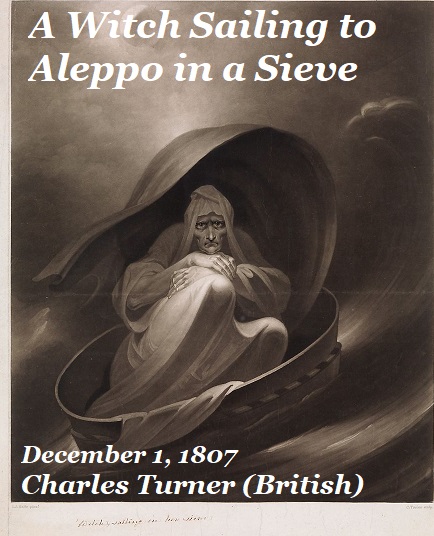
イングランドよりも魔女の迫害がずっと厳しかったスコットランドにおいて,ジェームズ一世は,デンマークから(スコットランドへ)の航海中彼を悩ませた大暴風雨の原因を発見するのに大いに成功した(beset 悩ます;四方から取り囲んで攻撃する)。フィアン博士とかいう名前の人(A certain Dr. Fian)は,拷問を受けて,この嵐はリース(注:現在エディンバラに一部となっている港町)からふるいに乗って(in a sieve)海に出帆した(had put to sea)何百人もの魔女によって生み出されたのだと告白した。 (注:sieve はふるい(漉し器)であるが,。漉し器にのったら水が入ってきてすぐに沈んでしまうはずなので「in a sieve (ふるい/漉し器)に乗って」とはどういうことか私も最初はわからなかった。ネットでいろいろ調べているうちに,go to sea in a sieve という表現があり,google の画像検索によって該当するイラストも発見できた。たとえばこんな詩もついていた。「やがて水が流れこみ ふるいはすっかり水びたし たたんだピンクの紙をだし ぬれないように足つつみ ピンでしっかり留めといた・・・」とある。また,シェークスピアの「マクベス」にも第一魔女が「亭主はタイガー号の船長やってて,アレッポへ航海中だから, あたしは篩(ふるい)の船で追っかけてやるんだ。」というセリフをしゃべっている。つまり,英国人なら「witches who had put to sea in a sieve 」とあればみな理解してしまうのであろう! 因みに,荒地出版社の津田訳では「海をふるいにかけたリース出の幾百もの女魔法師等によってこの嵐は生み出された」とひどい訳になっている)。 バートン(John Hill Burton, 1809-1881: スコットランドの歴史家)は彼の「スコットランド史」(第7巻 p.116)で述べているように,「この現象((大嵐/大暴風雨))の価値は,スカンジナヴィア側の魔女の協力団体(a co-operative body 協同組合?)により一層増大され,両者(スコットランドとスカンジナビアの喪女)は悪魔学の諸法則に関する決定的な(crucial 重要な)実験を提供した」。フィアン博士はすぐに自分の告白を撤回した。そこで拷問は大いにその厳しさを増した。彼の下肢(足)の骨は幾つかに折られたが彼は屈しなかった(obdurate 頑固な)。そこで,事の成り行き(the proceedings)を見ていたジェームズ一世は,新しい拷問方法を考案した。(即ち)迫害の犠牲者の指の爪ははがされ,針が頭まで突きさされた。しかし,今日の記録にも残っているように,「悪魔が彼の心の奥深くに住んでいたので,彼は以前に告白した全てのことを完全に否定した」。そこで,かれは焼き殺された。(原注:レッキー(著)『ヨーロッパにおける合理主義の歴史』第1巻p.114参照)
Chapter IV Demonology and Medicine, n.13
In Scotland, where the persecution of witches was much more severe than in England, James I had great success in discovering the causes of the tempests which had beset him on his voyage from Denmark. A certain Dr. Fian confessed, under torture, that the storms were produced by some hundreds of witches who had put to sea in a sieve from Leith. As Burton remarks in his History of Scotland (Vol. VII, p. 116): “The value of the phenomenon was increased by a co-operative body of witches on the Scandinavian side, the two affording a crucial experiment on the laws of demonology.” Dr. Fian immediately withdrew his confession, whereupon the torture was greatly increased in severity. The bones of his legs were broken in several pieces, but he remained obdurate. Thereupon James I, who watched the proceedings, invented a new torture : the victim’s finger-nails were pulled off, and needles thrust in up to the heads. But, as the contemporary record says : “So deeply had the devil entered into his heart, that hee utterly denied all that which he before avouched.” So he was burnt.
出典:Religion and Science, 1935, chapt. 4:
情報源:https://russell-j.com/beginner/RS1935_04-120.HTM
